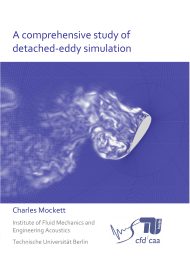A comprehensive study of detached-eddy simulation

Format: 14,8 x 21,0 cm
Publishing year: 2009
Detached-eddy simulation (DES) is a prominent example of a new family of methods that seek to bridge the gap existing in terms of computational cost and predictive accuracy between Reynolds-averaged Navier–Stokes (RANS) and large-eddy simulation (LES) approaches for turbulent flows. As such, DES targets computational resources expected to become widespread in the near future, and is expected to be particularly valuable for scenarios in which RANS is known to be unreliable (e.g. strongly-separated flow) or in which resolution of unsteady turbulent motion is required (e.g. computational aeroacoustics). In this work a comprehensive study of DES has been carried out. In the literature review, a detailed introduction of the method and its various derivative versions is offered together with a summary of the relevant turbulent flow physics. The presentation and discussion of results draws upon a wide selection of test cases, ranging between canonical and complex configurations and with a comprehensive variety of turbulent flow phenomena. The topics covered include elementary implementation issues and the verification and calibration of model features, the fundamental interaction of the model with the numerical scheme, the detailed comparison of DES results with wind tunnel experiments, the dependency of DES on the underlying RANS model in different scenarios, the sensitivity of DES to the choice of numerical time step, the importance of long simulation times for reliable statistics, the perspectives for a dynamic determination of the model parameter, the performance of a recent extension of the DES formulation when applied as a wall-modelled LES and a proposed extension to this that relaxes the stringent requirements on thewall-normal grid spacing. A concise summary of the principle findings is provided in the conclusion, which includes links to the relevant sub-sections for easy reference.



